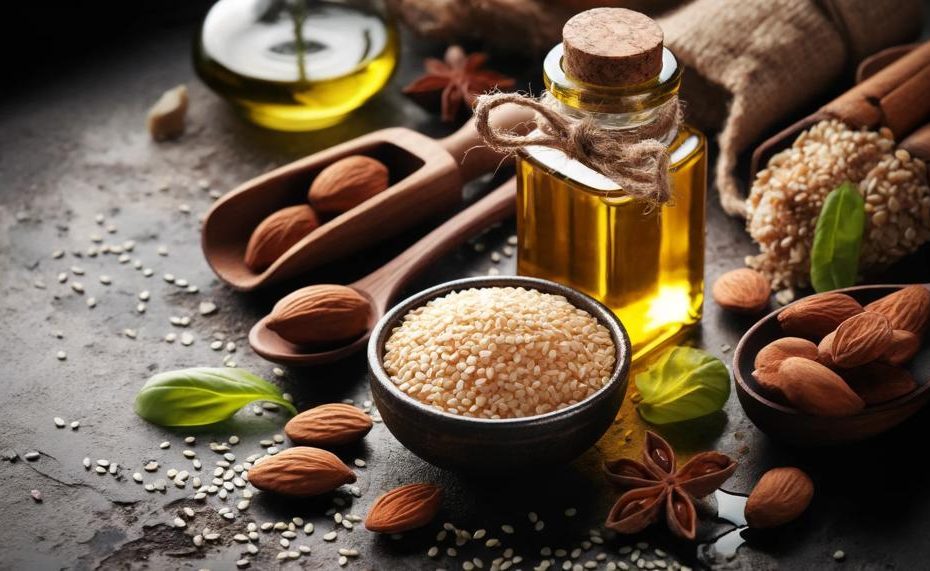While many people believe that refrigeration is necessary to preserve its flavor, the truth is that sesame oil can be stored in a cool and shaded place without compromising its taste. So, what should you do to ensure the longevity of your toasted sesame oil and maximize its shelf life? Let’s explore the facts.
So, does toasted sesame oil need to be refrigerated?
It is really preferable to have toasted sesame oil at ambient temperature rather than chilled. It might get hazy and taste less aromatic and subdued when refrigerated. Refrigeration, on the other hand, may help sesame oil last longer since it keeps the lipids from getting rancid.
The human diet has included sesame oil for longer than refrigeration has been available. It is also shelf-stable. Over time, certain oils have an oxidized flavor, also known as “rancidity,” which is a temperature-dependent chemical reaction.
Sesame oil freshness may suffer if the room temperature is too high. For instance, to preserve its maximum taste after opening, shirogoma paste, which resembles tahini, should be chilled.
Contents
- 1 How Long Does Toasted Sesame Oil Last?
- 2 Signs of Rancid Toasted Sesame Oil
- 3 How to Properly Store Toasted Sesame Oil
- 4 Can Rancid Sesame Oil Be Used for Cooking?
- 5 How to Check If Your Sesame Oil Has Gone Bad
- 6 Best Practices for Using Sesame Oil
- 7 The Difference Between Plain and Toasted Sesame Oil
- 8 Choosing the Best Brands of Sesame Oil
- 9 The Health Benefits of Sesame Oil
- 10 How to Use Sesame Oil in Cooking
- 11 The Role of Refrigeration in Preserving Sesame Oil
- 12 The Impact of Heat on Sesame Oil
- 13 The Debate on Refrigerating Certain Food Items
- 14 Conclusion
Key Takeaways:
- There is no clear consensus on whether toasted sesame oil needs to be refrigerated.
- Sesame oil can be stored in a cool and shaded place away from sunlight to preserve its flavor.
- Proper sealing and using the oil within a year of purchase are recommended for optimal freshness.
- Refrigeration can help extend the shelf life of toasted sesame oil, but it’s not necessary.
- Using fresh, non-rancid oil is essential for safe and flavorful cooking.
How Long Does Toasted Sesame Oil Last?
The shelf life of toasted sesame oil depends on several factors, including its quality, how and when it is opened, and how it is stored. For the best flavor, it is generally recommended to use a bottle of opened plain sesame oil within a year. As for toasted sesame oil, it is best to use it within six to nine months of opening for peak flavor.
If you have a bottle of sesame oil that has been sitting in your pantry for years, it is no longer good to use. Over time, the oil can go rancid and lose its quality and taste.
To extend the shelf life of toasted sesame oil, it is important to store it in a cool, dark place away from heat sources and direct sunlight. When not in use, make sure to tightly seal the cap to prevent air exposure, as the oxidation process can affect the oil’s flavor and quality.
By following these storage guidelines, you can enjoy the rich and aromatic flavor of toasted sesame oil for a longer period.
Signs of Rancid Toasted Sesame Oil
Rancid sesame oil can be easily identified by several signs that indicate spoilage. When sesame oil turns rancid, there will be noticeable changes in its color and texture. Light sesame oil that has gone bad will undergo a color change, becoming darker than its original shade. On the other hand, plain white sesame oil should maintain a very light color even when it expires.
Another sign of rancid sesame oil is the presence of sticky residue on the exterior of the bottle. If you notice a sticky substance on the outside, it is a clear indication that the oil has gone rancid and is no longer suitable for consumption.
Furthermore, the presence of mold or chunks in the oil is another abnormality that indicates spoilage. Fresh sesame oil should have a smooth consistency, free from any solid particles or visible signs of mold.
In addition to visual cues, rancid sesame oil also produces specific smells and flavors that are unpleasant. Rancid oil will have an unpleasant odor similar to paint thinner or nail polish remover, distinct from the characteristic aroma of fresh sesame oil. It may also have a bitter or acidic taste, contrary to the mild or toasty flavors found in plain or toasted sesame oil.
It is vital to discard rancid sesame oil as using it can compromise the taste of your dishes and potentially lead to health risks.
How to Properly Store Toasted Sesame Oil
Proper storage is key to maintaining the quality and extending the shelf life of toasted sesame oil. Follow these guidelines to ensure your oil stays fresh and flavorful:
- Choose a Cool Place: Store your toasted sesame oil in a cool area, away from heat sources and direct sunlight. Cooler temperatures help slow down the oxidation process, preserving the oil’s taste and aroma.
- Tightly Seal the Bottle: Always make sure to tightly seal the lid of the bottle after each use. This prevents air exposure and minimizes the oxidation rate, which can lead to a decrease in quality. A tightly sealed bottle maintains the oil’s freshness for a longer period.
- Consider Refrigeration: While not necessary, refrigeration can help preserve the rich flavor of toasted sesame oil. If you choose to refrigerate, be aware that the oil may become thicker in consistency. However, it will return to its normal consistency once brought back to room temperature.
- Avoid Fluctuating Temperatures: Fluctuating temperatures can degrade the quality of toasted sesame oil. Therefore, it’s advisable to store the oil in a place where temperatures remain consistent.
- Keep Away from Moisture: Moisture can promote the growth of bacteria and affect the quality of toasted sesame oil. Store the oil in a dry environment to avoid any issues.
By following these proper storage practices, you can ensure that your toasted sesame oil remains fresh, flavorful, and ready to enhance your culinary creations.
| Storage Tips | Description |
|---|---|
| Cool Place | Store the oil in a cool area away from heat sources and sunlight. |
| Tightly Sealed | Ensure the bottle is tightly sealed after each use to prevent air exposure. |
| Refrigeration | Consider refrigerating the oil to preserve its flavor, but be aware of texture changes. |
| Consistent Temperatures | Avoid fluctuating temperatures to maintain the quality of the oil. |
| Avoid Moisture | Store the oil in a dry environment to prevent bacterial growth. |
Can Rancid Sesame Oil Be Used for Cooking?
Using rancid sesame oil for cooking is not advisable due to potential health effects. While small amounts of rancid oil may not immediately harm you, prolonged consumption can be dangerous. The oxidation process of oil can lead to the formation of harmful free radicals, which can damage cells and contribute to chronic diseases, including cancer.
In addition to the health risks, cooking with rancid sesame oil can result in an unpleasant taste and potential digestive discomfort. The flavor of rancid oil is compromised, and it may impart off-putting flavors in your dishes. Consuming rancid oil can also cause digestive issues, such as nausea or stomach upset.
It is crucial to prioritize your health and well-being by discarding rancid oil and using fresh, non-rancid oil for cooking. By using high-quality sesame oil and replenishing your supply regularly, you can ensure safe consumption and maintain the desired flavor and aroma in your culinary creations.
“Using rancid sesame oil for cooking can have dangerous health effects due to the formation of free radicals and can result in an unpleasant taste and potential digestive discomfort.”
How to Check If Your Sesame Oil Has Gone Bad
Various methods can be employed to determine if your sesame oil has gone bad. Checking the expiration date on the bottle is a good starting point, but the oxidation process of oil can vary. Changes in color, such as darkening in light sesame oil, and changes in texture, such as thickening when cold, can indicate spoilage. If the exterior of the bottle feels sticky, it may be a sign of rancidity. Unpleasant odors, like paint thinner or nail polish remover, can also signify that the oil has gone bad. Tasting a drop of the oil can help identify acidic, sour, or bitter flavors associated with rancidity.
| Sesame Oil Gone Bad Indicators | Description |
|---|---|
| Color Change | Darkening in light sesame oil |
| Texture Change | Thickening when cold |
| Sticky Exterior | Sign of rancidity |
| Unpleasant Odors | Similar to paint thinner or nail polish remover |
| Off Flavors | Acidic, sour, or bitter taste |
Best Practices for Using Sesame Oil
When it comes to utilizing sesame oil in your culinary creations, there are certain best practices to follow in order to maintain its optimal freshness and flavor. By implementing these guidelines, you can ensure that every dish you prepare with sesame oil delights your taste buds. Here are some key recommendations:
- Opt for smaller bottles: If you don’t use sesame oil frequently, consider purchasing smaller bottles. This helps minimize air exposure, allowing you to utilize the oil before it loses its freshness. Plus, smaller bottles are easier to store and handle.
- Choose high-quality oil: Investing in high-quality sesame oil from reputable producers is worth it. These brands prioritize quickly moving their inventory, ensuring that you receive a fresh and flavorful product every time.
- Avoid mixing with older oil: When opening a new bottle of sesame oil, it’s best to avoid mixing it with any leftover oil from an older bottle. Older oil may have already begun to degrade in freshness, potentially impacting the overall quality of your dish.
- Use the oil quickly: Sesame oil is at its best when used promptly. Incorporate it into your recipes as soon as possible to fully enjoy its rich and distinct flavor. The longer sesame oil sits unused, the greater the chance of it losing its freshness.
By following these best practices, you can make the most of your sesame oil and elevate the taste of your dishes. Now, let’s explore the benefits of using different types of sesame oil in your cooking.
Different Types of Sesame Oil
“Sesame oil comes in various types, each offering its own unique flavor profile and culinary possibilities. Whether you choose plain or toasted sesame oil depends on the desired impact on your dish. Here’s a quick overview of the main types: “
| Type of Sesame Oil | Flavor | Aroma | Uses |
|---|---|---|---|
| Plain Sesame Oil | Light and subtle | Mild fragrance | Suitable for sautéing vegetables and as a replacement for other cooking oils |
| Toasted Sesame Oil | Strong and nutty | Intensely aromatic | Used as a finishing oil, in salad dressings, marinades, and to add depth to dishes |
The Difference Between Plain and Toasted Sesame Oil
When it comes to sesame oil, there are two main types: plain or untoasted sesame oil and toasted sesame oil. Each type offers unique flavors and aromas that can elevate your dishes in different ways.
Plain Sesame Oil
Plain sesame oil is made from raw sesame seeds, giving it a light color and a subtle flavor and aroma. It is often used as a replacement for vegetable or canola oil in cooking. The mild and delicate taste of plain sesame oil makes it a great choice for sautéing vegetables, as it enhances their natural flavors without overpowering them. Additionally, it can be used as a base for salad dressings or as a light drizzle over dishes.
Toasted Sesame Oil
On the other hand, toasted sesame oil is made from roasted sesame seeds, resulting in a darker color and a stronger sesame flavor and nutty aroma. The toasting process intensifies the natural flavors of the sesame seeds, giving the oil a rich and robust taste. Toasted sesame oil is commonly used as a finishing oil, adding depth and complexity to dishes. Its distinct flavor pairs well with Asian-inspired recipes, such as stir-fries, marinades, and sauces. Additionally, it can be drizzled over cooked dishes like noodles or rice for an extra burst of flavor.
Choosing the Right Sesame Oil
The choice between plain and toasted sesame oil depends on the desired flavor impact in your dish. If you’re looking for a subtle and versatile oil that won’t overpower other ingredients, opt for plain sesame oil. On the other hand, if you want a stronger sesame flavor and a nutty aroma to enhance your dishes, go for toasted sesame oil. By choosing the right type of sesame oil, you can add a unique and delicious twist to your culinary creations.
Choosing the Best Brands of Sesame Oil
When it comes to selecting sesame oil brands, there is a range of reputable options available to suit various culinary needs. Whether you’re looking for a versatile option for marinades and dressings or a finishing oil with nuanced flavors, there are brands that have earned trust and recognition.
For everyday use in marinades and dressings, two well-known and widely available brands to consider are Kadoya and Ottogi. These brands offer sesame oils that are ideal for enhancing the flavors of your dishes.
For those seeking a more refined and distinctive sesame oil, smaller producers like Momofuku, Wadaman, Dong He, and Queens Bucket have gained popularity for their exceptional offerings.
Exploring the Flavor Profiles of Select Brands
Momofuku: Known for its toasted sesame oil, Momofuku infuses a rich and toasty flavor into their oil, making it suitable for adding depth to various dishes.
Wadaman: Wadaman specializes in producing deeply nutty black sesame oil. Its distinct flavor profile adds complexity and richness to any recipe.
Dong He: Dong He offers a cold-pressed white sesame oil, which preserves the natural flavors and delicate aroma of sesame seeds. It is an excellent choice for those seeking a more subtle taste.
Queens Bucket: Queens Bucket’s lightly toasted sesame oil strikes a delicate balance between flavor and aroma. It is an ideal option for those who prefer a milder sesame taste.
The Quest for Quality
When considering sesame oil brands, it is important to look for reputable producers dedicated to delivering high-quality products. These brands often prioritize maintaining freshness and ensuring their oils are packed with flavor.
“The commitment to quality from brands like Momofuku, Wadaman, Dong He, and Queens Bucket exemplify the excellence that can be found in the world of sesame oil.” – Sesame Oil Connoisseur
Comparing Sesame Oil Brands
| Brand | Flavor Profile | Usage |
|---|---|---|
| Kadoya | Mild and versatile | Marinades, dressings |
| Ottogi | Light and nutty | Marinades, dressings |
| Momofuku | Rich and toasty | Finishing oil, salad dressings |
| Wadaman | Deeply nutty | Finishing oil, dipping sauce |
| Dong He | Subtle and delicate | Salad dressings, stir-fries |
| Queens Bucket | Mild and aromatic | Finishing oil, sautéing |
As seen in the table above, each brand offers unique flavor profiles that can elevate your cooking experience. Consider the intended usage of the sesame oil and select a brand that aligns with your taste preferences and culinary goals.
The Health Benefits of Sesame Oil
Sesame oil is not only a flavorful ingredient in cooking but also offers numerous health benefits. Its composition and nutritional profile make it a valuable addition to a balanced diet. One of the key advantages of sesame oil is its high Vitamin E content, which provides powerful antioxidant properties. Antioxidants help protect the body from oxidative stress and may have potential benefits for heart health, reducing the risk of heart disease.(sesame oil, health benefits, Vitamin E, heart disease)
Furthermore, sesame oil possesses anti-inflammatory properties, which can contribute to a healthier body. Chronic inflammation is associated with various diseases, including heart disease, diabetes, and obesity. Regular consumption of sesame oil may help reduce inflammation and lower the risk of developing these conditions.(sesame oil, health benefits, inflammation)
Sesame oil has also been studied for its potential to aid in blood sugar control. High blood sugar levels can lead to diabetes and other metabolic disorders. Preliminary research suggests that sesame oil may help improve insulin sensitivity and regulate blood sugar levels, making it a beneficial choice for individuals with diabetes or those at risk of developing the condition.(sesame oil, health benefits, blood sugar control)
Incorporating sesame oil into your diet as a substitute for other cooking oils can offer a healthier alternative. Its unique combination of flavors and its potential to support heart health, reduce inflammation, and aid in blood sugar control make it a versatile and valuable addition to your culinary repertoire.(sesame oil, health benefits)
How to Use Sesame Oil in Cooking
Sesame oil is a versatile ingredient that can elevate the flavor of a wide range of dishes. Its distinctive nutty and toasty flavor profile adds depth and complexity without overpowering other ingredients. Let’s explore some delicious ways to incorporate sesame oil into your cooking:
Marinades
Add a splash of sesame oil to your marinades for a delectable twist. The oil’s fragrant aroma and rich flavor infuse meats, poultry, or vegetables, enhancing their taste and tenderness.
Dressings
Bring your salads to life by using sesame oil in dressings. Combine it with soy sauce, rice vinegar, ginger, and garlic for a delightful Asian-inspired dressing that complements fresh greens or noodle salads.
Stir-fries
When stir-frying, start by heating a small amount of sesame oil in the wok or pan. Its intense taste will permeate the dish, creating a robust and satisfying flavor profile. Remember, a little goes a long way!
Sauces
Sesame oil is a key flavor component in many sauces. Whether you’re making a tangy sesame dipping sauce for dumplings or a savory stir-fry sauce, adding sesame oil will provide a delightful depth of flavor.
Sesame oil is a versatile ingredient that can take your cooking to the next level. Its unique flavor is particularly well-suited for marinades, dressings, stir-fries, and sauces.
Don’t be afraid to get creative and experiment with different recipes and cuisines. You’ll be amazed at the wonderful flavors and aromas that sesame oil can bring to your dishes. Just remember to use it sparingly, as its potent taste can easily overpower other ingredients.
| Recipe | Main Ingredients |
|---|---|
| Asian Sesame Chicken Marinade | Chicken, sesame oil, soy sauce, ginger, garlic, honey |
| Sesame Ginger Dressing | Sesame oil, soy sauce, rice vinegar, ginger, garlic, honey |
| Beef and Broccoli Stir-Fry | Beef, broccoli, sesame oil, soy sauce, garlic, ginger |
| Spicy Sesame Noodles | Noodles, sesame oil, soy sauce, chili garlic sauce, green onions |

The Role of Refrigeration in Preserving Sesame Oil
While refrigeration is not mandatory for sesame oil, it can play a vital role in prolonging its freshness and preserving its flavor. Refrigerating toasted sesame oil, in particular, can help maintain its rich aroma for a longer period.
When refrigerating sesame oil, it is crucial to ensure that the bottle is properly sealed to prevent any absorption of odors or moisture that could compromise its quality. This will help preserve the true essence and integrity of the oil.
It’s important to note that refrigeration may cause the oil to become thicker in texture. However, once the oil is brought back to room temperature, it will return to its normal consistency, ready to be used in your culinary creations.
The Impact of Heat on Sesame Oil
Sesame oil, especially toasted sesame oil, has a lower smoke point compared to other cooking oils. This means that it is not suitable for high-temperature cooking methods like deep frying. Exposing sesame oil to high heat can cause it to burn and alter its flavor, resulting in a bitter taste. It is best to use sesame oil in lower heat cooking techniques such as sautéing, stir-frying, or as a finishing touch to already cooked dishes.
The Debate on Refrigerating Certain Food Items
The topic of refrigeration for food storage can be a subject of debate for certain items. While some foods benefit from refrigeration to extend their freshness, others are best stored outside the fridge. Understanding the specific storage requirements of each item is crucial for maintaining optimal quality and flavor.
Foods that Benefit from Refrigeration
Refrigeration can help preserve the freshness of certain foods, including:
- Maple syrup: Storing maple syrup in the refrigerator can prevent spoilage and extend its shelf life.
- Unrefined nut oils like sesame oil: These oils can benefit from refrigeration to maintain their flavor and prevent rancidity.
- Ketchup: Keeping ketchup refrigerated helps prevent bacterial growth and maintains its quality for a longer time.
Foods that Should be Stored Outside the Fridge
While refrigeration is beneficial for some foods, there are certain items that should not be stored in the refrigerator:
- Chocolate: Storing chocolate in the fridge can cause it to develop a white, powdery coating called “bloom” and alter its texture.
- Tomatoes: Refrigerating tomatoes can negatively affect their texture and flavor. It is best to store them at room temperature.
- Soy sauce: Soy sauce can remain stable at room temperature and does not require refrigeration.
- Hot sauce: Most hot sauces have a high acidity and low pH level, which helps prevent the growth of bacteria. They can be safely stored outside the fridge.
- Honey: Honey has natural preservatives that inhibit the growth of bacteria, making refrigeration unnecessary.
- Coffee beans: Coffee beans should be stored in an airtight container in a cool, dry place, away from moisture and strong odors.
- Bread: Storing bread in the fridge can cause it to become stale faster. It is best to store bread in a bread box or at room temperature.
Each food item has its own unique storage requirements based on factors such as moisture, texture, and ingredient composition. By following the recommended storage guidelines for each food, you can maintain the optimal quality and flavor of your ingredients.
| Food | Refrigeration | Storage Recommendation |
|---|---|---|
| Maple syrup | Beneficial | Refrigerate to extend shelf life |
| Sesame oil | Beneficial | Refrigerate unopened bottles |
| Ketchup | Beneficial | Refrigerate for longer shelf life |
| Chocolate | Not recommended | Store in a cool, dry place |
| Tomatoes | Not recommended | Store at room temperature |
| Soy sauce | Not recommended | Store at room temperature |
| Hot sauce | Not recommended | Store at room temperature |
| Honey | Not recommended | Store in a cool, dry place |
| Coffee beans | Not recommended | Store in a cool, dry place |
| Bread | Not recommended | Store at room temperature |
Conclusion
In conclusion, proper storage practices are essential for maintaining the continued freshness and optimal flavor of sesame oil. By following the recommended guidelines, you can ensure that your sesame oil remains in its best condition for various culinary applications.
Firstly, it is important to store sesame oil in a cool, dark place to protect it from heat and sunlight. This helps to preserve its flavor and prevent oxidation. Additionally, tightly sealing the lid of the bottle minimizes air exposure, which can lead to rancidity.
While refrigeration is not necessary for all types of sesame oil, it can be beneficial for some varieties, such as toasted sesame oil. Refrigerating the oil can help maintain its rich aroma and prolong its shelf life. However, it is important to ensure that the oil is tightly sealed and protected from absorbing any odors or moisture from the refrigerator.
Lastly, it is crucial to discard any rancid sesame oil, even though it may not cause immediate harm. Consuming rancid oil can have potential long-term health effects due to the presence of free radicals. To ensure optimal flavor and quality, it is recommended to use fresh, non-rancid oil and avoid consuming oil that has expired or gone bad.
Source Links
- https://www.epicurious.com/expert-advice/how-to-store-sesame-oil
- https://guide.michelin.com/hk/en/article/features/refrigerate-or-not
- https://foreignfork.com/does-sesame-oil-go-bad/





